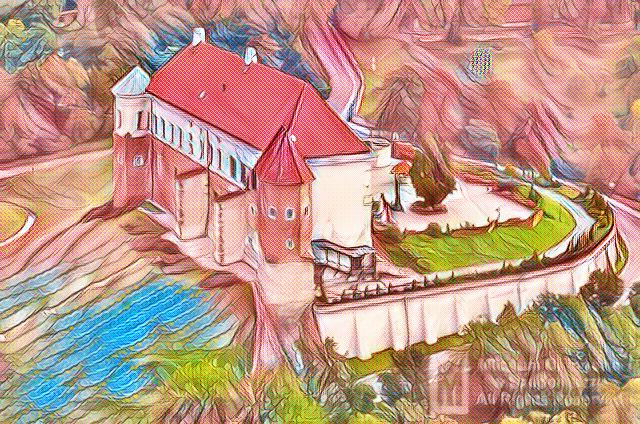SANDOMIERZ

Sandomierz Royal Castle's website
 The Royal Castle in Sandomierz The Royal Castle in Sandomierz |  Sandomierz-i Királyi Várkastély Sandomierz-i Királyi Várkastély |
|
 Királyi várkastély SandomierzbenA kastélyt a XIV. Század közepén építették a régi, XI. vagy XII. században épült erődítmény helyén, a Visztula bal partján, egy csonka hegytetőn. Ez a hegy a folyóval együtt hatékony védelmet nyújtott az ellenség ellen. Abban az időben megerősített faszerkezetű volt a központi épület. A tizenkettedik században földvár és vízes árok vették körül. 1138-ban, III. Bolesław Wrymouth végrendeletében Sandomierz volt a hercegség regionális fõvárosa, és a „fából készült várkastélyt” megtették Sandomierz hercegeinek állandó lakóhelyévé. A legjelentősebb hercegek a Sandomierz Henrik, az Igazságos Kazimierz, a Szemérmes Boleslaw és a Fekete Leszek voltak. A tizennegyedik században, Nagy Káimir király megalapításával, a „fa vár” helyére a nyolcszögletű, kőből faragott téglákból épített védőbástyát, a kastély falait gótikus stílusban átépítette. A Sandomierz vára egyik része a Kazimierz király által épített 32 várnak, amelyek nemzetvédelem megerősítését szolgálták. Sandomierz abban az időben Lengyelország egyik legfontosabb központja volt. A várkastély a királyi kormányzósági székhellyé vált, miközben gyakran volt szórakozó, pihenő helye a lengyel uralkodóknak, többek között, például Jadwiga királynőnek és férjének, Wladyslaw Jagellónak és Casimir királynak, a Jagellóknak, akiknek az uralkodása kb. 1480 körül felépítették az úgynevezett „tyúk lábat”, a vár déli tornyát, a vár máig fennmaradt legrégebbi részét. A tizenhatodik században I. Zsigmond király megkezdte a gótikus kastély reneszánsz rezidenciává alakítását. A munkával a Sandomierz-i építészt, Benedictust bízta meg. Benedictus mester újjáépítette a meglévő déli szárnyat, felállították a keleti szárnyat és megkezdték a nyugati szárny építését. A rekonstrukciót egy alkalmi felírat örökítette meg: "Isten kegyelméből Zygmunt, lengyel király, litván nagyherceg, orosz, porosz örökös uralkodó az anno domini 1520". A következő II. Zsigmond Augustus király uralkodása alatt a munka folytatódott. A tizenhatodik század második felében a befejezetlen szerkezetből egy négyszögletes reneszánsz várkastélyt alakítottak ki, amely közigazgatási bíróságként szolgált és a kormányzók székhelye lett. Amikor 1656 április 3-án János Kázmér lengyel király volt, a visszahúzódó svéd hadsereg felrobbantotta a Sandomierz várát. A keleti és a déli szárnyak megsemmisültek. A legkevésbé sérült a befejezetlen nyugati szárny. III. Sobieski János király parancsára a vár egy részét a palota különálló épülettípusában újjáépítették, amely a mai napig fennmaradt. Azóta a vár középületté vált: iroda, bíróság és börtön. Lengyelország harmadik felosztása után az osztrák betolakodók a várból bíróságot és börtönt csináltak. 1825-ben orosz börtön lett. 1844-ben a várat megváltoztatták, királyi palotából szigorú klasszicista építészeti formára. A tizenkilencedik század végén a börtön félkör alakú udvarát mint új szárnyként hozták létre ún. „félholdként” lengyelül „körként”. Ebben a formában a börtön 1959-ig szolgált. Az 1965-1986-as években alapos felújítást és helyreállítást hajtottak végre. 1986-ban a városi tanács döntése alapján a kastélyba telepítették a Sandomierzi Kerületi Múzeumot. 1995-2002-ben és 2004-2007-ben a kastélyhegy rekonstrukciójával és stabilizálásával, valamint a kastély belsejének revitalizációjával kapcsolatos munkákat végeztek. A múzeum legfontosabb műtárgyai a XIII. századi - szinte teljes - sakk készlet, amelyet a Sandomierz-i régészeti munkák során fedeztek fel, és a Nagy Kazimierz koronájának a másolata. A iparművészeti gyűjteményében egyedülálló csíkos köves ékszergyűjteménnyel rendelkezik, amely alapján nevezik Sandomierz-et a „Csíkos Flint világ fővárosának”. |
